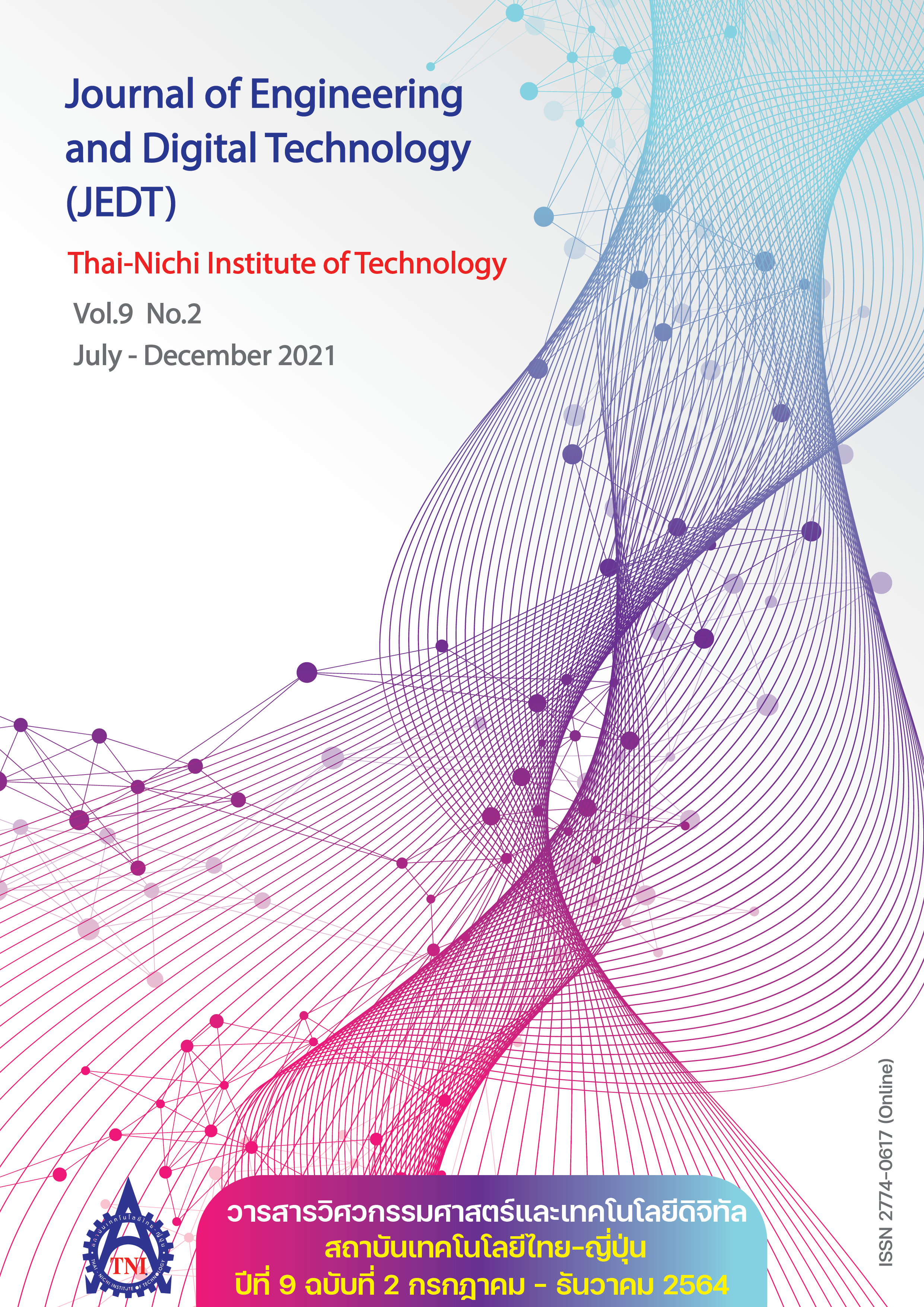Potential of Biogas Production by Co-Digestion between Physical Pretreatment Sugar Cane Leaf and Cow Dung
Main Article Content
Abstract
This research studied the potential of biogas production by co-digestion between physically pretreated sugarcane leaf and cow dung. The biogas production system was operated until optimum for operation. The optimum ratio of sugarcane leaf and cow dung was 1:1. Sugarcane leaf was physically pretreated to small sizes and 16 g L-1 CaCO3 maintained the optimum pH and alkalinity in system. The alkalinity can be maintained between 1,480–4,640 mg L-1 CaCO3; pH was 6.95–7.15. This is optimum pH for microbial mechanisms in the system. However, before biogas production sugarcane leaf component analysis, cellulose 39.096 ± 0.559%, hemicellulose 25.291 ± 0.937%, and lignin 18.556 ± 1.399%. The potential of the biogas production test by co-digestion between sugarcane leaf and cow dung was found to have the highest percentage of methane production 65.11 ± 0.30%, highest cumulative total gas 1,978 ± 3.54 mL, and highest total cumulative methane 1,148 ± 5.00 mL. Therefore, this research presented that sugarcane leaf and cow dung can be used for biogas production and that sugarcane leaf that is agricultural waste can be material for producing alternative energy in the community.
Article Details

This work is licensed under a Creative Commons Attribution-NonCommercial-NoDerivatives 4.0 International License.
Article Accepting Policy
The editorial board of Thai-Nichi Institute of Technology is pleased to receive articles from lecturers and experts in the fields of engineering and technology written in Thai or English. The academic work submitted for publication must not be published in any other publication before and must not be under consideration of other journal submissions. Therefore, those interested in participating in the dissemination of work and knowledge can submit their article to the editorial board for further submission to the screening committee to consider publishing in the journal. The articles that can be published include solely research articles. Interested persons can prepare their articles by reviewing recommendations for article authors.
Copyright infringement is solely the responsibility of the author(s) of the article. Articles that have been published must be screened and reviewed for quality from qualified experts approved by the editorial board.
The text that appears within each article published in this research journal is a personal opinion of each author, nothing related to Thai-Nichi Institute of Technology, and other faculty members in the institution in any way. Responsibilities and accuracy for the content of each article are owned by each author. If there is any mistake, each author will be responsible for his/her own article(s).
The editorial board reserves the right not to bring any content, views or comments of articles in the Journal of Thai-Nichi Institute of Technology to publish before receiving permission from the authorized author(s) in writing. The published work is the copyright of the Journal of Thai-Nichi Institute of Technology.
References
W. Kaewpradit, “Sugarcane straw management to mitigate particulate matter and encourage sustainable sugarcane production,” (in Thai), Khon Kaen Agr. J., vol. 49, no. 1, pp. 76–86, Feb. 2021.
T. Kaisinburasak, W. Opanukul, A. Opanukul, W. Sukpraserk, M. Kantamarat, and M. Tunhaw, “The Design and Mechanism Developing of Sugarcane Leaf Pruning Machine for sugarcane planting,” (in Thai), Thai Agr. Res. J., vol. 34, no. 1, pp. 76–94, 2016.
World Bank and Institute for Health Metrics and Evaluation. “The Cost of Air Pollution: Strengthening the Economic Case for Action.” WORLDBANK.org. https://openknowledge.worldbank.org/handle/10986/25013 (accessed Feb. 25, 2021).
S. Polprasert, “Pretreatment of lignocellulosic materials for ethanol production,” (in Thai), Thai Sci. Technol. J., vol. 22, no. 5, pp. 641–649, 2014.
N. Pisutpaisal, V. Sawasdee, P. Prommanee, and S. Haosagul, “Potential biogas generation from organic wastes in the EGAT,” unpublished.
National Science and Technology Development Agency, “BCG in Action Bio- Circular - Green Economy,” Bangkok, Thailand. Accessed: Feb 25, 2021. [Online]. Available: http://stiic.sti.or.th/wp-content/uploads/2018/10/BCG_Final1.pdf
S. Sirianuntapiboon, Wastewater Treatment System, Bangkok, Thailand: Top Publishing (in Thai), 2014.
F. Tufaner and Y. Avsar, “Effects of co-substrate on biogas production from cattle manure: a review,” Int. J. Environ. Sci. Technol., vol. 13, pp. 2303–2312, Jul. 2016.
N. Paraksa and S. Paraksa, Animal Nutrition, Nakhonpathom, Thailand: Kasetsart University Kamphaeng Saen Campus (in Thai), 2010.
A. M. Mansor, J. S. Lim, F. N. Ani, H. Hashim and W. S. Ho, “Characteristics of cellulose, hemicellulose and lignin of MD2 pineapple biomass,” Chem. Eng. Trans., vol. 72, pp. 79–84, Jan. 2019.
V. Sawasdee, S. Haosagul, and N. Pisutpaisal, “Co-digestion of waste glycerol and glucose to enhance biogas production,” Int. J. Hydrog. Energy, vol. 44, no. 56, pp. 29575–29582, Nov. 2019.
S. Fatma, A. Hameed, M. Noman, T. Ahmed, M. Shahid, M. Tariq, I. Sohail, and R. Tabassum, “Lignocellulosic Biomass: A Sustainable Bioenergy Source for the Future,” Protein Pept. Lett., vol. 25, no. 2, pp. 1–16, Jan. 2018.
R. Pawongrat, “Pretreatment processes for enhancing the efficiency of ethanol production from lignocellulosic agricultural wastes,” (in Thai), Veridian E-Journal, Sci. Technol. Silpakorn Univ., vol. 2, no. 1, pp. 143–157, Jun. 2015.
W. Soontornchaiboon, T. Plyngam, and R. Pawongrat, “Pretreatment of coconut husk for biogas production by anaerobic fermentation with cow dung,” (in Thai), RMUTP Res. J., vol. 9, no. 2, pp. 19–30, Sep. 2015.
M. Suntikunaporn, S. Echaroj, and W. Rimpikul, “Evaluation of Agricultural Wastes for Biogas Production,” Thammasat Int. J. Sci. Technol., vol. 19, no. 1, pp. 1–8, Mar. 2014.
E. Tamburini, M. Gaglio, G. Castaldelli, and E. A. Fano, “Biogas from Agri-Food and Agricultural Waste Can Appreciate Agro-Ecosystem Services: The Case Study of Emilia Romagna Region,” Sustainability, vol. 12, no. 20, pp. 1–15, Oct. 2020.


